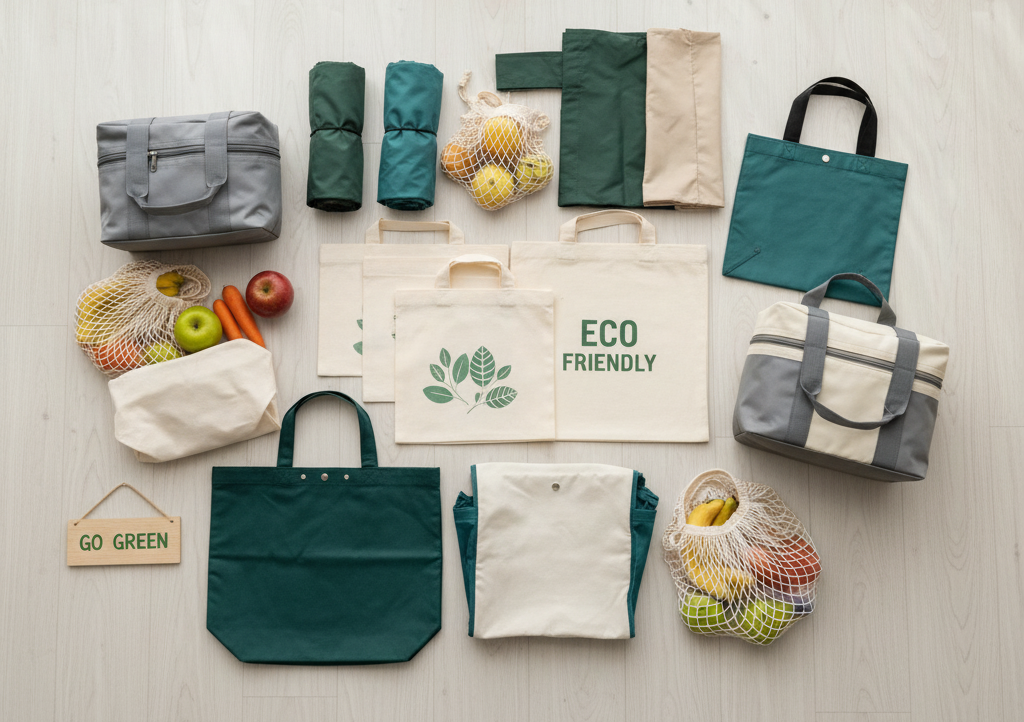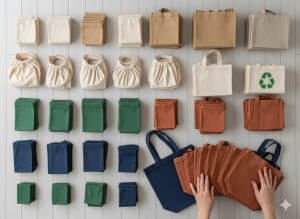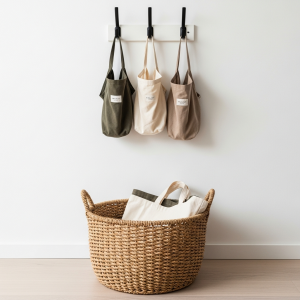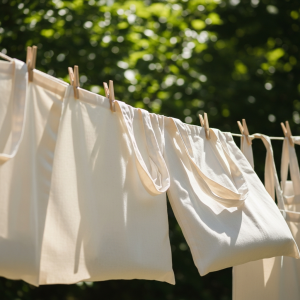Manage Your Reusable Bags Stash and Stay Truly Eco-Friendly
Managing your reusable bags stash may not sound like a pressing issue, until your household owns over 30 reusable grocery bags, many of which sit unused or forgotten. What began as an eco-friendly solution to reduce plastic waste has, for many, turned into another clutter challenge. Instead of reducing consumption, people find themselves overwhelmed by a mountain of totes, insulated bags, and promotional freebies.
In this guide, I’ll walk you through a few practical steps to manage and prevent your reusable bags stash from becoming a problem. These tips will help you stay organized, save money, and ensure your eco-friendly habits actually live up to their name.
The problem is simple: too many bags, not enough organization, and the risk that reusable bags become just as wasteful as single-use plastics. The good news? It doesn’t have to be this way. With some structure, intention, and a few smart strategies, your stash can become a powerful ally in sustainable living at home.
Smart Steps to Manage and Prevent Your Reusable Bags from Becoming a Problem
1. Take Stock of Your Current Reusable Bags
Before you can manage your reusable bags stash, you need to know what you’re working with. For most people, the pile has grown slowly over the years, a bag picked up at a conference, another gifted by a store, maybe one or two trendy cotton totes bought because they “looked eco-friendly.” Before long, you have more than you’ll ever use.
Lay them all out on the floor. Count them, sort them by material (cotton, polyester, recycled plastic, insulated), and check their condition. Be honest about which ones you actually use. If a bag is torn, flimsy, or stained beyond repair, set it aside for recycling. If you have 10 duplicates of the same style, keep only what’s practical.
For a single person, 5–7 bags may be plenty. For couples, 8–10 is a good range. Families with kids might need 12–15 to cover big grocery hauls, laundry trips, and farmers’ markets. Anything beyond that is likely just clutter.
You can also look at investing a little more in an organic tote bag instead of paper bags. Those paper bags can be reused, they have a very short life span and cannot be washed if they get dirty (which they definitely will). I found these Cotton Organic Tote bags to be pretty dependable and the reviews seem to agree.
Pro tip: Think of your bags as part of your weekly grocery “wardrobe.” If you wouldn’t wear 40 identical T-shirts, why stockpile 40 totes?
2. Designate a Storage Space
Once you’ve trimmed your reusable bags stash, the next step is organization. Bags become a problem when they’re scattered everywhere, some in the car, some under the sink, some in the laundry room. The result? When it’s time to shop, you can’t find any of them.
Designate a home base for your bags. This could be:
-
A woven basket by the front door
-
A hanging hook in the mudroom
-
A collapsible bin in your car trunk
-
A drawer in the kitchen
By assigning one dedicated spot, you create a habit loop leading to better management of them, reducing the possibility of clutter. Every time you come home from shopping, your reusable bags return to the same place. Every time you head out, you know exactly where to grab them.
Think of it like your car keys. If you never set them down in the same spot, you’d waste time searching. Your reusable bags are the same, consistency prevents chaos.
This collapsible storage bin which we installed and use in our closet. The fact that they are foldable and come in different colors provide you unparalleled flexibility in your choice for how and where to use them. Check it out and others like this on Amazon.
3. Create a Grab-and-Go System
Even with storage, it’s easy to forget your bags when you’re in a rush. That’s where a grab-and-go system saves the day.
Always keep one or two compact, foldable bags tucked into your purse, backpack, or glove compartment. These bags roll or fold into palm-sized pouches, so they’re convenient for last-minute shopping trips.
At the same time, store a set of bags permanently in your car trunk. If you always shop with the car, this ensures you’ll never have to rely on single-use plastic. For urban dwellers who walk or take transit, consider keeping one in your work bag and one by the door.
Quick Tip: As soon as you unpack your groceries, put the bags right back in their designated spot. Don’t leave them piled on the kitchen counter.
4. Put a Limit on Your Reusable Bag Stash
Here’s the hard truth: more isn’t always better. Owning too many reusable bags can be just as wasteful as hoarding plastic ones.
Decide on a reasonable limit based on your lifestyle. Write that number down and commit to it. For example:
-
Solo shoppers: 5–7 bags
-
Couples: 8–10 bags
-
Families: 12–15 bags
Once you hit your limit, any new bags you acquire should replace an old one. If you’re tempted to pick up a promotional tote, ask yourself: Do I actually need this?
Hypothetical case study: A family in Toronto capped their stash at 12 bags. They rotated them weekly, washed them regularly, and donated extras to a local food bank. As a result, their bags were used consistently, and they felt lighter without the clutter.
5. Clean and Maintain Your Reusable Bags
Reusable bags are only eco-friendly if they’re safe and long-lasting. A 2010 University of Arizona study found bacteria in nearly all reusable bags tested, with E. coli present in over 12%. The culprit? Rarely, if ever, washing them.
To make your stash last:
-
Wash cotton totes every 2–3 weeks in the laundry.
-
Wipe polyester bags with a damp cloth after use.
-
Clean insulated bags with mild soap, especially if used for meat or dairy.
-
Assign bags for specific uses: produce, dry goods, meats.
By creating a routine, you extend the lifespan of each bag and protect your family’s health. Clean bags are also sturdier, smell better, and feel fresher to use.
6. Repurpose or Donate Extra Reusable Bags
If you still find yourself with more bags than you need, don’t let them sit unused. Repurpose them creatively:
-
Use a tote as a laundry hamper for small loads.
-
Store toys or craft supplies in colorful bags.
-
Keep a few in your car for road trips.
-
Use one as a gym bag or picnic tote.
Better yet, donate extras to community organizations. Food banks, thrift shops, and community centers often welcome reusable bags since they can distribute them to families in need.
Pro tip: If the bag is branded, it might even become a conversation starter for someone else.
Affiliate Tip: DIY labeling kits for repurposed bags [Insert affiliate link].
7. Be Mindful of New Bags
Finally, the best way to manage your reusable bags stash is to prevent it from growing unnecessarily. Be intentional with what you bring home.
Say no to freebies unless you truly need another bag. Avoid buying trendy totes just because they look good. Instead, focus on using the ones you already own.
Mindset shift: Treat bags like part of your capsule wardrobe. Only add new pieces when you need them, and ensure each one serves a purpose.
Affiliate Tip: High-quality multipurpose totes that can replace 3–4 flimsy ones [Insert affiliate link].
Why This Matters
Reusable bags are an amazing step forward from single-use plastics. They cut down on pollution, save resources, and support sustainable living. But here’s the twist: they’re not automatically “green” just because they’re reusable.
-
Environmental Impact
Cotton totes, polyester shoppers, and recycled plastic bags all require resources to make. A 2018 UK Environmental Agency study found that a cotton tote must be reused at least 131 times to offset its environmental footprint compared to one plastic bag. When households hoard dozens of totes that never see the light of day, the intended eco-friendly habit turns into more consumption. -
Clutter and Waste
An overflowing pile of bags by the front door or in the trunk can make life feel more chaotic. Some households even end up accepting more plastic bags at checkout because they can’t find their reusable stash. -
Health Concerns
According to a University of Arizona study, 97% of people never wash their reusable bags, and many harbor bacteria from groceries. Left unmanaged, reusable bags can pose hygiene risks as well. -
Practical Living
Managing your reusable bags stash ensures you only keep what you need, you use it regularly, and you care for it properly. This supports other eco-friendly habits like free eco-friendly shopping, zero waste shopping, and mindful consumption.
When done right, your reusable bags become a symbol of sustainable living at home. When ignored, they risk turning into clutter that undermines your eco goals.
Common Mistakes to Avoid
-
Collecting bags without thinking, free doesn’t mean eco-friendly, so avoid doing this.
-
Forgetting to wash your bags, bacteria can build up quickly, so you want to clean your bags regularly.
-
Keeping bags in multiple random spots, which leads to forgetting them. Find a specific location for storing them
-
Hoarding duplicates, more isn’t greener. Get in the habit of picking up the ones you have at home
-
Accepting new bags without assessing need, just don’t. Prevention is the best solution.
Wrap Up
Managing your reusable bags stash is about more than staying organized, it’s about making sure your eco-friendly habits live up to their potential. A clutter-free, intentional stash means your bags get used enough times to justify their footprint, your home feels lighter, and your routines are smoother.
Start small today: lay out your bags, pick your favorites, and donate the rest. By tomorrow, you’ll feel the difference in both your space and your shopping habits.
👉 Subscribe to NatGreenTips for weekly insights on zero waste shopping and sustainable living at home. And if you need replacements, check out our curated list of durable reusable bags [Insert affiliate link].
FAQ
Q: How many reusable bags do I really need?
A: Most households do well with 8–12. The key isn’t quantity, but consistent use.
Q: How often should I wash reusable bags?
A: Cotton bags every 2–3 weeks, insulated bags after each use, and polyester bags as needed.
Q: Can I recycle old reusable bags?
A: Yes. Many textile recycling programs accept them, or you can repurpose them at home.
Q: How do I make sure I never forget my bags?
A: Keep a few in your car, one in your purse, and always return them to their designated spot after use.








